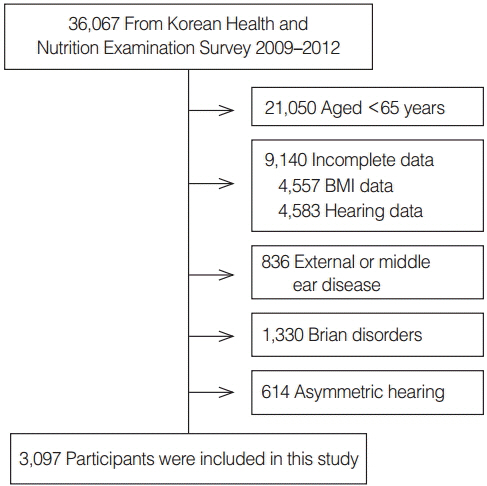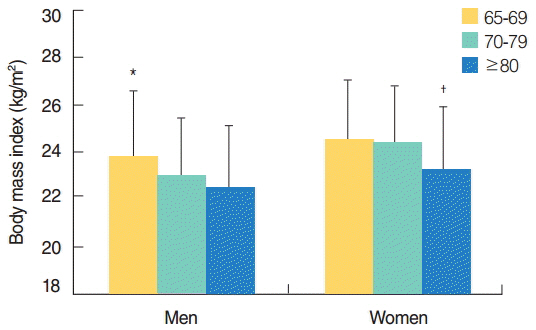Clin Exp Otorhinolaryngol.
2016 Jun;9(2):123-130. 10.21053/ceo.2015.00955.
Is Body Mass Index Associated With the Development of Age-Related Hearing Impairment in Koreans? The Korean National Health and Nutrition Examination Survey 2009-2012
- Affiliations
-
- 1Department of Otorhinolaryngology-Head and Neck Surgery, Kyungpook National University Hospital, Kyungpook National University College of Medicine, Daegu, Korea. kylee@knu.ac.kr
- KMID: 2165054
- DOI: http://doi.org/10.21053/ceo.2015.00955
Abstract
OBJECTIVES
The aim of this study was to evaluate whether body mass index (BMI) is associated with age-related hearing loss (ARHL) in the Asian elderly population.
METHODS
Data from the Korean National Health and Nutrition Examination Survey 2009-2012 were used for the analyses. The pure tones at 0.5 and 1 kHz of both ears of each subject were averaged to obtain the low-frequency, those at 2 and 3 kHz were averaged to obtain the mid-frequency, and those at 4 and 6 kHz were averaged to obtain the high-frequency. The average hearing threshold (AHT) was calculated as pure tone average at 4 frequencies in the better ear. ARHL was defined as the AHT >25 dB.
RESULTS
Univariate analyses revealed an increase in the BMI tertile in men was associated with a decreased low-frequency threshold, while an increase in the BMI tertile in women was associated with decreased mid- and high-frequency thresholds. Multivariate analyses adjusted for confounders show no significant differences in low-, mid-, or high-frequency. There was no significant difference in the prevalence of ARHL by BMI tertiles. Linear regression analyses show no association between BMI and low-, mid-, and high-frequency or AHTs. The area under the receiver operating characteristic curve values for AHT was 0.515 in men and 0.522 in women. The logistic regression analyses showed no association between BMI and ARHL in either sex.
CONCLUSION
BMI is not advantageous for the prediction of ARHL. In future epidemiological studies, BMI as a covariate of obesity may be replaced by other active metabolic parameters that have better predictive ability of ARHL than BMI.
Keyword
MeSH Terms
Figure
Cited by 1 articles
-
Relationships Among Factors Relevant to Abdominal Fat and Age-Related Hearing Loss
Young Lee, Mina Park
Clin Exp Otorhinolaryngol. 2017;10(4):309-314. doi: 10.21053/ceo.2017.00017.
Reference
-
1. Huang Q, Tang J. Age-related hearing loss or presbycusis. Eur Arch Otorhinolaryngol. 2010; Aug. 267(8):1179–91.
Article2. Bao J, Ohlemiller KK. Age-related loss of spiral ganglion neurons. Hear Res. 2010; Jun. 264(1-2):93–7.
Article3. Bielefeld EC, Tanaka C, Chen GD, Henderson D. Age-related hearing loss: is it a preventable condition? Hear Res. 2010; Jun. 264(1-2):98–107.
Article4. Fetoni AR, Picciotti PM, Paludetti G, Troiani D. Pathogenesis of presbycusis in animal models: a review. Exp Gerontol. 2011; Jun. 46(6):413–25.
Article5. Fransen E, Topsakal V, Hendrickx JJ, Van Laer L, Huyghe JR, Van Eyken E, et al. Occupational noise, smoking, and a high body mass index are risk factors for age-related hearing impairment and moderate alcohol consumption is protective: a European populationbased multicenter study. J Assoc Res Otolaryngol. 2008; Sep. 9(3):264–76.
Article6. Helzner EP, Patel AS, Pratt S, Sutton-Tyrrell K, Cauley JA, Talbott E, et al. Hearing sensitivity in older adults: associations with cardiovascular risk factors in the health, aging and body composition study. J Am Geriatr Soc. 2011; Jun. 59(6):972–9.
Article7. Curhan SG, Eavey R, Wang M, Stampfer MJ, Curhan GC. Body mass index, waist circumference, physical activity, and risk of hearing loss in women. Am J Med. 2013; Dec. 126(12):1142.
Article8. Hwang JH, Wu CC, Hsu CJ, Liu TC, Yang WS. Association of central obesity with the severity and audiometric configurations of age-related hearing impairment. Obesity (Silver Spring). 2009; Sep. 17(9):1796–801.
Article9. Shargorodsky J, Curhan SG, Eavey R, Curhan GC. A prospective study of cardiovascular risk factors and incident hearing loss in men. Laryngoscope. 2010; Sep. 120(9):1887–91.
Article10. Centre for Disease Control and Prevention. Anthropometric reference data for children and adults: United States, 2007-2010. Data from the National Health and Nutrition Examination Survey [Internet]. Hyattsville (ML): U.S. Department of Health and Human Services, Centers for Disease Control and Prevention, National Center for Health Statistics;2012. [cited 2015 Aug 5]. Available from: http://www.cdc.gov/nchs/data/series/sr_11/sr11_252.pdf.11. Rehm J, Room R, Monteiro M, Gmel G, Graham K, Rehn N, et al. Alcohol use. Ezzati M, Lopez AD, Rodgers A, Murray CJL. Alcohol use. Comparative quantification of health risks: global and regional burden of disease attributable to selected major risk factors. Geneva: World Health Organization;2004. p. 959–1108.12. National Health Information Portal. Alcohol drinking [Internet]. Sejong: Ministry of Health and Health;2015. [cited 2015 Aug 5]. Available from: http://health.mw.go.kr/HealthPromotionArea/HealthInfo/View.do?idx=5800&subIdx=4&searchCate=&searchType=&searchKey=&pageNo=1.13. Kang JW, Choi HS, Kim K, Choi JY. Dietary vitamin intake correlates with hearing thresholds in the older population: the Korean National Health and Nutrition Examination Survey. Am J Clin Nutr. 2014; Jun. 99(6):1407–13.
Article14. Gates GA, Cobb JL, D’Agostino RB, Wolf PA. The relation of hearing in the elderly to the presence of cardiovascular disease and cardiovascular risk factors. Arch Otolaryngol Head Neck Surg. 1993; Feb. 119(2):156–61.
Article15. Barrenas ML, Jonsson B, Tuvemo T, Hellstrom PA, Lundgren M. High risk of sensorineural hearing loss in men born small for gestational age with and without obesity or height catch-up growth: a prospective longitudinal register study on birth size in 245,000 Swedish conscripts. J Clin Endocrinol Metab. 2005; Aug. 90(8):4452–6.16. Atlantis E, Martin SA, Haren MT, Taylor AW, Wittert GA; Members of the Florey Adelaide Male Ageing Study. Inverse associations between muscle mass, strength, and the metabolic syndrome. Metabolism. 2009; Jul. 58(7):1013–22.
Article17. Liu P, Ma F, Lou H, Liu Y. The utility of fat mass index vs. body mass index and percentage of body fat in the screening of metabolic syndrome. BMC Public Health. 2013; Jul. 13:629.
Article18. Despres JP, Moorjani S, Lupien PJ, Tremblay A, Nadeau A, Bouchard C. Regional distribution of body fat, plasma lipoproteins, and cardiovascular disease. Arteriosclerosis. 1990; Jul-Aug. 10(4):497–511.
Article19. Kishida K, Funahashi T, Shimomura I. Adiponectin as a routine clinical biomarker. Best Pract Res Clin Endocrinol Metab. 2014; Jan. 28(1):119–30.
Article20. Hwang JH, Hsu CJ, Liu TC, Yang WS. Association of plasma adiponectin levels with hearing thresholds in adults. Clin Endocrinol (Oxf). 2011; Nov. 75(5):614–20.
Article21. Tanigawa T, Shibata R, Ouchi N, Kondo K, Ishii M, Katahira N, et al. Adiponectin deficiency exacerbates age-related hearing impairment. Cell Death Dis. 2014; Apr. 5:e1189.
Article22. Wu CC, Tsai CH, Lu YC, Lin HC, Hwang JH, Lin YH, et al. Contribution of adiponectin and its type 1 receptor to age-related hearing impairment. Neurobiol Aging. 2015; Jun. 36(6):2085–93.
Article23. Lalwani AK, Katz K, Liu YH, Kim S, Weitzman M. Obesity is associated with sensorineural hearing loss in adolescents. Laryngoscope. 2013; Dec. 123(12):3178–84.
Article24. Meigs JB, Wilson PW, Fox CS, Vasan RS, Nathan DM, Sullivan LM, et al. Body mass index, metabolic syndrome, and risk of type 2 diabetes or cardiovascular disease. J Clin Endocrinol Metab. 2006; Aug. 91(8):2906–12.
Article25. Wildman RP, Muntner P, Reynolds K, McGinn AP, Rajpathak S, Wylie-Rosett J, et al. The obese without cardiometabolic risk factor clustering and the normal weight with cardiometabolic risk factor clustering: prevalence and correlates of 2 phenotypes among the US population (NHANES 1999-2004). Arch Intern Med. 2008; Aug. 168(15):1617–24.
Article26. Karelis AD. Metabolically healthy but obese individuals. Lancet. 2008; Oct. 372(9646):1281–3.
Article27. Jee SH, Sull JW, Park J, Lee SY, Ohrr H, Guallar E, et al. Body-mass index and mortality in Korean men and women. N Engl J Med. 2006; Aug. 355(8):779–87.
Article28. Kim TS, Park SW, Kim do Y, Kim EB, Chung JW, So HS. Visceral adipose tissue is significantly associated with hearing thresholds in adult women. Clin Endocrinol (Oxf). 2014; Mar. 80(3):368–75.
Article29. Kang SH, Jung da J, Cho KH, Park JW, Yoon KW, Do JY. The association between metabolic syndrome or chronic kidney disease and hearing thresholds in Koreans: the Korean National Health and Nutrition Examination Survey 2009-2012. PLoS One. 2015; Mar. 10(3):e0120372.
Article30. Cruickshanks KJ, Nondahl DM, Dalton DS, Fischer ME, Klein BE, Klein R, et al. Smoking, central adiposity, and poor glycemic control increase risk of hearing impairment. J Am Geriatr Soc. 2015; May. 63(5):918–24.
Article
- Full Text Links
- Actions
-
Cited
- CITED
-
- Close
- Share
- Similar articles
-
- Influence of the coexistence of visual impairment, hearing impairment, and masticatory discomfort on the quality of life of middle-aged adults: an analysis based on the 2019 and 2020 Korea National Health and Nutrition Examination Survey
- The association between long working hours and hearing impairment in noise unexposed workers: data from the 5th Korea National Health and Nutrition Examination Survey (KNHANES 2010–2012)
- Body Fat Percentile Curves for Korean Children and Adolescents: A Data from the Korea National Health and Nutrition Examination Survey 2009-2010
- Association between Body Mass Index and Dental Caries: Based on the Korea National Health and Nutrition Examination Survey 2013 – 2015
- Letter: Relationships between Walking, Body Mass Index, and Risk Factors of Metabolic Syndrome among Korean Adults: Data from the Fifth Korea National Health and Nutrition Examination Survey (2010-2012) (Korean J Obes 2015;24:108-15)




